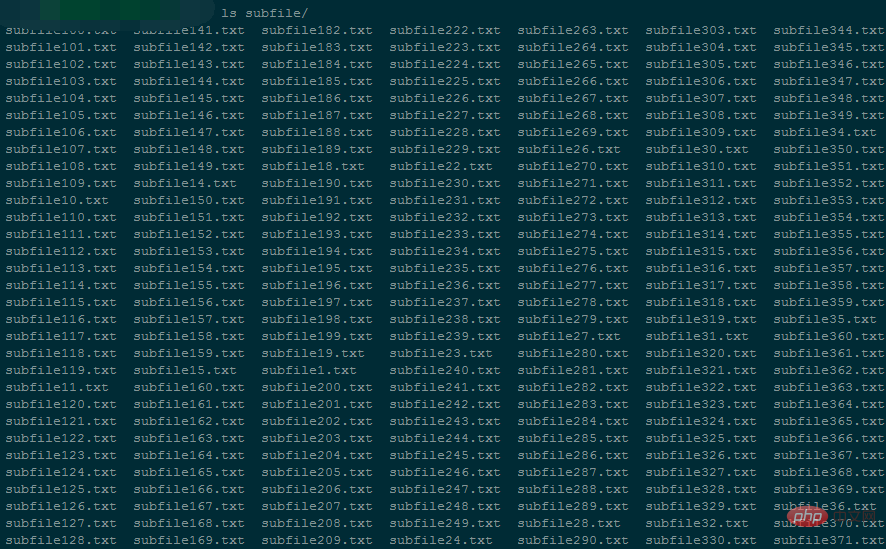问题一:一个文件含有5亿行,每行是一个随机整数,需要对该文件所有整数排序。
分治(pide&Conquer),参考大数据算法:对5亿数据进行排序
对这个一个500000000行的 total.txt 进行排序,该文件大小 4.6G。
每读10000行就排序并写入到一个新的子文件里(这里使用的是快速排序)。
1.分割 & 排序
#!/usr/bin/python2.7
import time
def readline_by_yield(bfile):
with open(bfile, 'r') as rf:
for line in rf:
yield line
def quick_sort(lst):
if len(lst) < 2:
return lst
pivot = lst[0]
left = [ ele for ele in lst[1:] if ele < pivot ]
right = [ ele for ele in lst[1:] if ele >= pivot ]
return quick_sort(left) + [pivot,] + quick_sort(right)
def split_bfile(bfile):
count = 0
nums = []
for line in readline_by_yield(bfile):
num = int(line)
if num not in nums:
nums.append(num)
if 10000 == len(nums):
nums = quick_sort(nums)
with open('subfile/subfile{}.txt'.format(count+1),'w') as wf:
wf.write('\n'.join([ str(i) for i in nums ]))
nums[:] = []
count += 1
print count
now = time.time()
split_bfile('total.txt')
run_t = time.time()-now
print 'Runtime : {}'.format(run_t)会生成 50000 个小文件,每个小文件大小约在 96K左右。

程序在执行过程中,内存占用一直处在 5424kB 左右

整个文件分割完耗时 94146 秒。
2.合并
#!/usr/bin/python2.7
# -*- coding: utf-8 -*-
import os
import time
testdir = '/ssd/subfile'
now = time.time()
# Step 1 : 获取全部文件描述符
fds = []
for f in os.listdir(testdir):
ff = os.path.join(testdir,f)
fds.append(open(ff,'r'))
# Step 2 : 每个文件获取第一行,即当前文件最小值
nums = []
tmp_nums = []
for fd in fds:
num = int(fd.readline())
tmp_nums.append(num)
# Step 3 : 获取当前最小值放入暂存区,并读取对应文件的下一行;循环遍历。
count = 0
while 1:
val = min(tmp_nums)
nums.append(val)
idx = tmp_nums.index(val)
next = fds[idx].readline()
# 文件读完了
if not next:
del fds[idx]
del tmp_nums[idx]
else:
tmp_nums[idx] = int(next)
# 暂存区保存1000个数,一次性写入硬盘,然后清空继续读。
if 1000 == len(nums):
with open('final_sorted.txt','a') as wf:
wf.write('\n'.join([ str(i) for i in nums ]) + '\n')
nums[:] = []
if 499999999 == count:
break
count += 1
with open('runtime.txt','w') as wf:
wf.write('Runtime : {}'.format(time.time()-now))程序在执行过程中,内存占用一直处在 240M左右


跑了38个小时左右,才合并完不到5千万行数据...
虽然降低了内存使用,但时间复杂度太高了;可以通过减少文件数(每个小文件存储行数增加)来进一步降低内存使用。
问题二:一个文件有一千亿行数据,每行是一个IP地址,需要对IP地址进行排序。
IP地址转换成数字
# 方法一:手动计算
In [62]: ip
Out[62]: '10.3.81.150'
In [63]: ip.split('.')[::-1]
Out[63]: ['150', '81', '3', '10']
In [64]: [ '{}-{}'.format(idx,num) for idx,num in enumerate(ip.split('.')[::-1]) ]
Out[64]: ['0-150', '1-81', '2-3', '3-10']
In [65]: [256**idx*int(num) for idx,num in enumerate(ip.split('.')[::-1])]
Out[65]: [150, 20736, 196608, 167772160]
In [66]: sum([256**idx*int(num) for idx,num in enumerate(ip.split('.')[::-1])])
Out[66]: 167989654
In [67]:
# 方法二:使用C扩展库来计算
In [71]: import socket,struct
In [72]: socket.inet_aton(ip)
Out[72]: b'\n\x03Q\x96'
In [73]: struct.unpack("!I", socket.inet_aton(ip))
# !表示使用网络字节顺序解析, 后面的I表示unsigned int, 对应Python里的integer or long
Out[73]: (167989654,)
In [74]: struct.unpack("!I", socket.inet_aton(ip))[0]
Out[74]: 167989654
In [75]: socket.inet_ntoa(struct.pack("!I", 167989654))
Out[75]: '10.3.81.150'
In [76]:问题三:有一个1.3GB的文件(共一亿行),里面每一行都是一个字符串,请在文件中找出重复次数最多的字符串。
基本思想:迭代读大文件,把大文件拆分成多个小文件;最后再归并这些小文件。
拆分的规则:
迭代读大文件,内存中维护一个字典,key是字符串,value是该字符串出现的次数;
当字典维护的字符串种类达到10000(可自定义)的时候,把该字典按照key从小到大排序,然后写入小文件,每行是 key\tvalue;
然后清空字典,继续往下读,直到大文件读完。
归并的规则:
首先获取全部小文件的文件描述符,然后各自读出第一行(即每个小文件字符串ascii值最小的字符串),进行比较。
找出ascii值最小的字符串,如果有重复的,这把各自出现的次数累加起来,然后把当前字符串和总次数存储到内存中的一个列表。
然后把最小字符串所在的文件的读指针向下移,即从对应小文件里再读出一行进行下一轮比较。
当内存中的列表个数达到10000时,则一次性把该列表内容写到一个最终文件里存储到硬盘上。同时清空列表,进行之后的比较。
一直到读完全部的小文件,那么最后得到的最终文件就是一个按照字符串ascii值升序排序的大的文件,每一行的内容就是 字符串\t重复次数,
最后迭代去读这个最终文件,找出重复次数最多的即可。
1. 分割
def readline_by_yield(bfile):
with open(bfile, 'r') as rf:
for line in rf:
yield line
def split_bfile(bfile):
count = 0
d = {}
for line in readline_by_yield(bfile):
line = line.strip()
if line not in d:
d[line] = 0
d[line] += 1
if 10000 == len(d):
text = ''
for string in sorted(d):
text += '{}\t{}\n'.format(string,d[string])
with open('subfile/subfile{}.txt'.format(count+1),'w') as wf:
wf.write(text.strip())
d.clear()
count += 1
text = ''
for string in sorted(d):
text += '{}\t{}\n'.format(string,d[string])
with open('subfile/subfile_end.txt','w') as wf:
wf.write(text.strip())
split_bfile('bigfile.txt')2. 归并
import os
import json
import time
import traceback
testdir = '/ssd/subfile'
now = time.time()
# Step 1 : 获取全部文件描述符
fds = []
for f in os.listdir(testdir):
ff = os.path.join(testdir,f)
fds.append(open(ff,'r'))
# Step 2 : 每个文件获取第一行
tmp_strings = []
tmp_count = []
for fd in fds:
line = fd.readline()
string,count = line.strip().split('\t')
tmp_strings.append(string)
tmp_count.append(int(count))
# Step 3 : 获取当前最小值放入暂存区,并读取对应文件的下一行;循环遍历。
result = []
need2del = []
while True:
min_str = min(tmp_strings)
str_idx = [i for i,v in enumerate(tmp_strings) if v==min_str]
str_count = sum([ int(tmp_count[idx]) for idx in str_idx ])
result.append('{}\t{}\n'.format(min_str,str_count))
for idx in str_idx:
next = fds[idx].readline() # IndexError: list index out of range
# 文件读完了
if not next:
need2del.append(idx)
else:
next_string,next_count = next.strip().split('\t')
tmp_strings[idx] = next_string
tmp_count[idx] = next_count
# 暂存区保存10000个记录,一次性写入硬盘,然后清空继续读。
if 10000 == len(result):
with open('merged.txt','a') as wf:
wf.write(''.join(result))
result[:] = []
# 注意: 文件读完需要删除文件描述符的时候, 需要逆序删除
need2del.reverse()
for idx in need2del:
del fds[idx]
del tmp_strings[idx]
del tmp_count[idx]
need2del[:] = []
if 0 == len(fds):
break
with open('merged.txt','a') as wf:
wf.write(''.join(result))
result[:] = []归并结果分析:
| 分割时内存中维护的字典大小 | 分割的小文件个数 | 归并时需维护的文件描述符个数 | 归并时内存占用 | 归并耗时 | |
| 第一次 | 10000 | 9000 | 9000 ~ 0 | 200M | 归并速度慢,暂未统计完成时间 |
| 第二次 | 100000 | 900 | 900 ~ 0 | 27M | 归并速度快,只需2572秒 |
3. 查找出现次数最多的字符串及其次数
import time
def read_line(filepath):
with open(filepath,'r') as rf:
for line in rf:
yield line
start_ts = time.time()
max_str = None
max_count = 0
for line in read_line('merged.txt'):
string,count = line.strip().split('\t')
if int(count) > max_count:
max_count = int(count)
max_str = string
print(max_str,max_count)
print('Runtime {}'.format(time.time()-start_ts))归并后的文件共9999788行,大小是256M;执行查找耗时27秒,内存占用6480KB。
以上是一文了解大文件排序/外存排序问题的详细内容。更多信息请关注PHP中文网其他相关文章!
 Python vs. C:了解关键差异Apr 21, 2025 am 12:18 AM
Python vs. C:了解关键差异Apr 21, 2025 am 12:18 AMPython和C 各有优势,选择应基于项目需求。1)Python适合快速开发和数据处理,因其简洁语法和动态类型。2)C 适用于高性能和系统编程,因其静态类型和手动内存管理。
 Python vs.C:您的项目选择哪种语言?Apr 21, 2025 am 12:17 AM
Python vs.C:您的项目选择哪种语言?Apr 21, 2025 am 12:17 AM选择Python还是C 取决于项目需求:1)如果需要快速开发、数据处理和原型设计,选择Python;2)如果需要高性能、低延迟和接近硬件的控制,选择C 。
 达到python目标:每天2小时的力量Apr 20, 2025 am 12:21 AM
达到python目标:每天2小时的力量Apr 20, 2025 am 12:21 AM通过每天投入2小时的Python学习,可以有效提升编程技能。1.学习新知识:阅读文档或观看教程。2.实践:编写代码和完成练习。3.复习:巩固所学内容。4.项目实践:应用所学于实际项目中。这样的结构化学习计划能帮助你系统掌握Python并实现职业目标。
 最大化2小时:有效的Python学习策略Apr 20, 2025 am 12:20 AM
最大化2小时:有效的Python学习策略Apr 20, 2025 am 12:20 AM在两小时内高效学习Python的方法包括:1.回顾基础知识,确保熟悉Python的安装和基本语法;2.理解Python的核心概念,如变量、列表、函数等;3.通过使用示例掌握基本和高级用法;4.学习常见错误与调试技巧;5.应用性能优化与最佳实践,如使用列表推导式和遵循PEP8风格指南。
 在Python和C之间进行选择:适合您的语言Apr 20, 2025 am 12:20 AM
在Python和C之间进行选择:适合您的语言Apr 20, 2025 am 12:20 AMPython适合初学者和数据科学,C 适用于系统编程和游戏开发。1.Python简洁易用,适用于数据科学和Web开发。2.C 提供高性能和控制力,适用于游戏开发和系统编程。选择应基于项目需求和个人兴趣。
 Python与C:编程语言的比较分析Apr 20, 2025 am 12:14 AM
Python与C:编程语言的比较分析Apr 20, 2025 am 12:14 AMPython更适合数据科学和快速开发,C 更适合高性能和系统编程。1.Python语法简洁,易于学习,适用于数据处理和科学计算。2.C 语法复杂,但性能优越,常用于游戏开发和系统编程。
 每天2小时:Python学习的潜力Apr 20, 2025 am 12:14 AM
每天2小时:Python学习的潜力Apr 20, 2025 am 12:14 AM每天投入两小时学习Python是可行的。1.学习新知识:用一小时学习新概念,如列表和字典。2.实践和练习:用一小时进行编程练习,如编写小程序。通过合理规划和坚持不懈,你可以在短时间内掌握Python的核心概念。
 Python与C:学习曲线和易用性Apr 19, 2025 am 12:20 AM
Python与C:学习曲线和易用性Apr 19, 2025 am 12:20 AMPython更易学且易用,C 则更强大但复杂。1.Python语法简洁,适合初学者,动态类型和自动内存管理使其易用,但可能导致运行时错误。2.C 提供低级控制和高级特性,适合高性能应用,但学习门槛高,需手动管理内存和类型安全。


热AI工具

Undresser.AI Undress
人工智能驱动的应用程序,用于创建逼真的裸体照片

AI Clothes Remover
用于从照片中去除衣服的在线人工智能工具。

Undress AI Tool
免费脱衣服图片

Clothoff.io
AI脱衣机

Video Face Swap
使用我们完全免费的人工智能换脸工具轻松在任何视频中换脸!

热门文章

热工具

SublimeText3汉化版
中文版,非常好用

SublimeText3 英文版
推荐:为Win版本,支持代码提示!

SublimeText3 Linux新版
SublimeText3 Linux最新版

WebStorm Mac版
好用的JavaScript开发工具

mPDF
mPDF是一个PHP库,可以从UTF-8编码的HTML生成PDF文件。原作者Ian Back编写mPDF以从他的网站上“即时”输出PDF文件,并处理不同的语言。与原始脚本如HTML2FPDF相比,它的速度较慢,并且在使用Unicode字体时生成的文件较大,但支持CSS样式等,并进行了大量增强。支持几乎所有语言,包括RTL(阿拉伯语和希伯来语)和CJK(中日韩)。支持嵌套的块级元素(如P、DIV),






